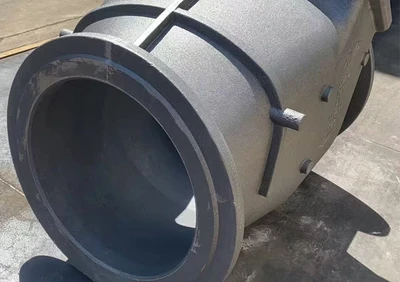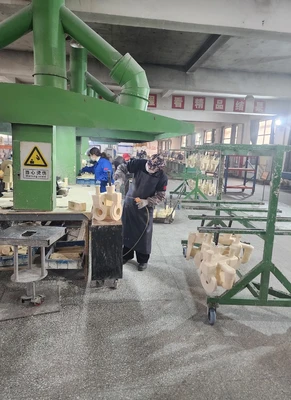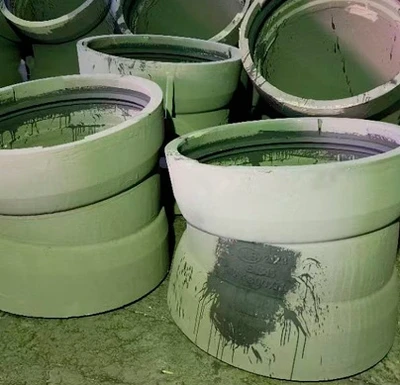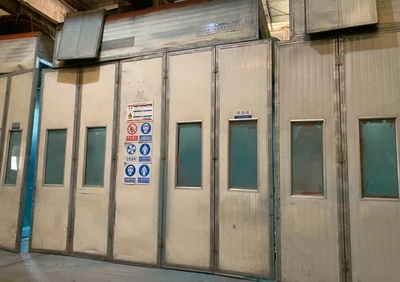When manufacturing components for agricultural machinery casting, choosing the right casting method is critical for balancing cost, quality, and performance. Lost foam casting and custom sand castings are two popular techniques, each with unique strengths. This blog compares these methods, focusing on their suitability for agricultural machinery casting, such as tractor parts and pump housings, and highlights why Balasen, a leading lost foam casting China provider, often opts for this innovative process. By understanding their differences, manufacturers can make informed decisions for their projects.
Lost foam casting involves creating a foam pattern, coating it with refractory material, and placing it in a dry sand mold. Molten metal vaporizes the foam, forming a precise casting. This method, used by Balasen in China, excels in producing complex parts for agricultural machinery casting with tolerances of CT6–CT9 and surface roughness of Ra 6.3–50 μm.
Custom sand castings, on the other hand, use sand molds formed around a reusable pattern (often wood or metal). The mold is removed after casting, leaving the metal part. This traditional method is versatile but typically achieves lower tolerances (CT8–CT12) and requires more machining. Both methods support materials like carbon steel casting China, alloy steel casting China, and manganese steel casting foundry alloys.
| Method | Tolerances | Surface Roughness | Complexity |
|---|---|---|---|
| Lost Foam Casting | CT6–CT9 | Ra 6.3–50 μm | High |
| Sand Casting | CT8–CT12 | Ra 12.5–100 μm | Moderate |
Lost foam casting offers several advantages that make it appealing for agricultural machinery casting:
Precision and Complexity: The process allows for intricate designs, such as engine blocks or gearbox covers, with minimal machining, reducing costs for carbon steel casting China projects.
Reduced Waste: Dry sand is recyclable, aligning with environmental goals, a priority for Balasen’s operations in Jiangsu, China.
Near-Net-Shape: Castings are close to the final shape, minimizing post-processing, which is ideal for high-volume production of tractor components.
For example, Balasen uses lost foam casting to produce durable manganese steel casting foundry parts for agricultural equipment, offering superior wear resistance for harsh field conditions. A 2022 study noted that lost foam casting can reduce machining time by 15–25% compared to sand casting for complex parts.
While lost foam casting excels in precision, it has some drawbacks:
Higher Initial Costs: Foam pattern creation can be expensive for low-volume runs, unlike custom sand castings, which use reusable patterns.
Porosity Risks: Improper process control can lead to defects like porosity, requiring stringent quality checks.
Material Limitations: While versatile, lost foam casting is best suited for ferrous alloys like carbon steel and alloy steel, whereas sand casting supports a broader range, including non-ferrous metals.
Custom sand castings are more cost-effective for simpler, larger parts or low-volume production, as sand molds are easier to produce. However, they often require more finishing, increasing labor costs for agricultural machinery casting.
| Factor | Lost Foam Casting | Sand Casting |
|---|---|---|
| Setup Cost | Higher (foam patterns) | Lower (reusable patterns) |
| Machining Needs | Minimal | Moderate to high |
| Production Volume | Medium to high | Low to high |
For agricultural machinery casting, lost foam casting is often preferred when precision and complexity are priorities. Balasen, a trusted lost foam casting China manufacturer, leverages this method to produce parts like pump housings and transmission components that meet ISO 9001 standards. The process’s ability to handle manganese steel casting foundry alloys ensures wear-resistant parts that withstand the rigors of agricultural environments.
In contrast, custom sand castings are better for larger, less complex parts, such as plow bases, where tolerances are less critical. However, for modern agricultural equipment requiring lightweight, precise components, lost foam casting offers a competitive edge. Its environmental benefits, like recyclable sand, also align with sustainable manufacturing trends.
Q1: Is lost foam casting better than sand casting?
Lost foam casting provides higher precision and less machining for complex parts, making it ideal for agricultural machinery casting, while custom sand castings are more cost-effective for simpler, low-volume parts.
Q2: What are the disadvantages of lost foam casting?
High initial pattern costs and potential porosity are key drawbacks, requiring careful process control to ensure quality.
Q3: What is the difference between lost foam and investment casting?
Lost foam casting uses foam patterns and dry sand, offering cost savings for larger parts, while investment casting uses wax patterns and ceramic molds for higher precision but at a higher cost.
Q4: What materials are used in lost foam casting for agriculture?
Carbon steel, alloy steel, manganese steel, and ductile iron are common, providing durability for agricultural machinery casting components like gearboxes and pump housings.
[1]. Wang, Y., et al. (2022). "Advances in lost foam casting for complex geometries." Journal of Manufacturing Processes, 74, 123–135.
[2]. Wikipedia. (2023). "Lost-foam casting." https://en.wikipedia.org/wiki/Lost-foam_casting
[3]. Balasen Equipment Co., Ltd. (2023). "Lost Foam Casting Services." https://www.balasen.com/products/lost-foam-casting/
[4]. International Organization for Standardization. (2018). "ISO 8062: Geometrical product specifications — Dimensional and geometrical tolerances for moulded and cast parts."
 Pump Shell-Ductile IronFebruary 27, 2025This is a great ductile iron part named pump shell used for pump industry area.Balasen designed advanced pouring system to feed and float into the mold cavity.We have opened pouring system deployment,...view
Pump Shell-Ductile IronFebruary 27, 2025This is a great ductile iron part named pump shell used for pump industry area.Balasen designed advanced pouring system to feed and float into the mold cavity.We have opened pouring system deployment,...view What Are the Differences Between Resin Sand Casting and Green Sand Casting?June 20, 2025Choosing the right casting method is crucial for producing high-quality metal components, especially for industries like agriculture. Resin sand casting and green sand casting are two widely used tech...view
What Are the Differences Between Resin Sand Casting and Green Sand Casting?June 20, 2025Choosing the right casting method is crucial for producing high-quality metal components, especially for industries like agriculture. Resin sand casting and green sand casting are two widely used tech...view What Is Resin Sand Casting and How Does It Work?June 20, 2025When it comes to manufacturing durable metal components for industries like agriculture, resin sand casting is a go-to method for producing high-quality, intricate parts. Known for its strength and pr...view
What Is Resin Sand Casting and How Does It Work?June 20, 2025When it comes to manufacturing durable metal components for industries like agriculture, resin sand casting is a go-to method for producing high-quality, intricate parts. Known for its strength and pr...view What Is Lost Foam Casting and How Does It Work?June 20, 2025In the world of metal casting, lost foam casting stands out as a versatile and innovative method, particularly for producing complex components used in industries like agricultural machinery casting. ...view
What Is Lost Foam Casting and How Does It Work?June 20, 2025In the world of metal casting, lost foam casting stands out as a versatile and innovative method, particularly for producing complex components used in industries like agricultural machinery casting. ...view Balasen Painting CapabilityFebruary 27, 2025Balasen has adequate painting equipment and capability; we can do maximum three layers of coating per client requirement. it includes primer, intermediate and final coat. The nominal thickness is 320 ...view
Balasen Painting CapabilityFebruary 27, 2025Balasen has adequate painting equipment and capability; we can do maximum three layers of coating per client requirement. it includes primer, intermediate and final coat. The nominal thickness is 320 ...view 2A Great Steel Casting and Machining Part Used for Industrial AreaFebruary 27, 2025This is a special steel casting and machining part produced by balasen company recently.The material is 42CrMo4. This is to export to Europe customer.material quality.Then we make a full machining fo...view
2A Great Steel Casting and Machining Part Used for Industrial AreaFebruary 27, 2025This is a special steel casting and machining part produced by balasen company recently.The material is 42CrMo4. This is to export to Europe customer.material quality.Then we make a full machining fo...view